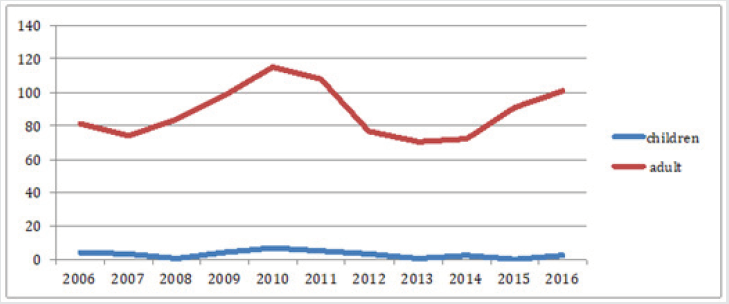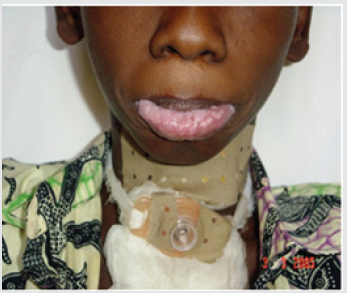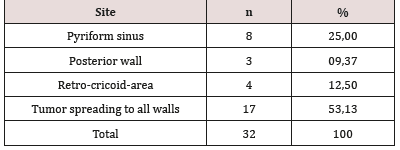
Lupine Publishers Group
Lupine Publishers
Menu
ISSN: 2641-1709
Research Article(ISSN: 2641-1709) 
Epidemiological Characteristics of Children Hypopharyngeal Squamous Cell Carcinoma Volume 3 - Issue 1
C Ndiaye1*, AFY Touré1, H Ahmed1, H Younes1, E S Diom2, S Maiga1, A Dieye1, A Thiam3, NF Thiam1, N Ndour1, MS Diouf3, MM Dieng4 and IC Ndiaye1
- 1ENT Department, FANN Teaching Hospital, Senegal
- 2ENT Department, University of Ziguinchor, Senegal
- 3ENT Department, General hospital of Grand Y off, Senegal
- 4Oncology Department, Aristide le Dantec Hospital, Senegal
Received:September 20, 2019; Published:October 03, 2019
Corresponding author: Ciré Ndiaye, ENT Department, FANN Teaching Hospital, Dakar, Senegal
DOI: 10.32474/SJO.2019.03.000155
Abstract
Introduction: Hypopharyngeal squamous cell carcinoma in children is extremely rare. In adults, this cancer is linked to tobacco and alcohol consumption, whereas in children, the etiological factors are unknown in addition to the lack of a suitable therapeutic protocol. The objective of this study is to describe the profile of squamous cell carcinoma of the hypopharynx in children and teenagers in Senegal.
Materials and Methods: For a period of 11 years dating from January 1, 2006 to December 31, 2016, we have performed a retrospective and descriptive study where in all patients with squamous cell carcinoma of the hypopharynx aged between 0 and 18 years were included and, have focused on sociodemographic aspects, clinical presentation, etiological factors and therapeutic outcomes.
Results: During this study, we identified 32 children with hypopharyngeal squamous cell carcinoma. The average age was 15.25 years with the extremes of 11 years and 18 years among which boys represented 60% of the series. The average time to consultation was 4.4 months.
No case of alcohol or tobacco consumption was found and 90.62% of patients were classified T3 or T4.
The treatment was palliative in many patients. All patients died within an average of 4.5 months.
Conclusion: The research of etiological factors and therapeutic protocols could help to improve the poor prognosis of this cancer in children.
Keywords: Child; Teenager; Cancer; Hypopharynx
Introduction
Squamous cell carcinoma of the hypopharynx is a cancer of adults over 65 years of age [1]. In children, hypopharyngeal cancer is extremely rare [2-5]. The first case was published in 1972 [5]. The large series of fifteen patients was reported by IC Ndiaye in Senegal [6]. In adults, this cancer is associated to tobacco and alcohol consumption, whereas in children, the etiological factors are unknown. The objective is to describe the profile of squamous cell carcinoma of the hypopharynx in children and teenagers in Senegal.
Patients and Methods
For a period of 11 years from January 1, 2006 to December 31, 2016 at the ENT department of FANN hospital, we conducted a retrospective and descriptive study wherein all patients with squamous cell carcinoma of the hypopharynx were aged between 0 and 18 years. The focus of the study was on sociodemographic aspects, clinical presentation, etiological factors and therapeutic outcomes.
Results
Thirty-two (32) patients that checked at our institution were diagnosed with hypopharyngeal squamous cell carcinoma, which represented 3.29% of all cases of hypopharyngeal cancer diagnosed during the eleven years of the study. Figure 1 shows the prevalence of hypopharyngeal cancer in recent years in adults and children.
Clinical Presentation
The average age was 15.25 years with extremes of 11 years and 18 years where boys represented 60% of the series with a sex ratio of 1.46. The consultation time was 4.4 months with extremes of 15 days and 12 months. No case of alcohol or tobacco consumption were found. Cervical nodes were found in 53% of patients. One patient had labial papillomatosis with hypopharyngeal cancer (Figure 2).
Paraclinical Aspects
All patients underwent endoscopy. The sites of the cancer are summarized in Table 1. All patients had an X-ray of the lungs. Only one case of pulmonary metastasis was noted. Patients with late medical check at stage T3T4 were 90.62% of cases. Anemia was noted in 59% of patients, the mean hemoglobinemia was 7.8g/dl with extremes between 5.7g / dl and 9.9g / dl.
Histological Results
Squamous cell carcinoma was found in all patients; in 2 patients, histological examination revealed HPV stigmas. Table 2 shows the TNM classification of all patients. HPV serology was not performed.
Therapeutic Data
Twenty five percent of patients received induction chemotherapy with 5FU and Cisplatin. Two of these patients received radiotherapy at a dose of 56Gy. Feeding gastrostomy was performed in 40% of patients and 60% benefited a nasogastric tube. Tracheotomy was performed in 97%.
Survival
All patients died within an average of 4.5 months.
Discussion
Hypopharyngeal Squamous cell carcinoma of children is a progressing cancer. It concerned 15 patients between 1995 and 2005 in our department [6]. Ten years later we had had 32 new cases. Despite this increase in number of cases, the prevalence stayed stable over the years compared to the adult population (Figure 1). The lack of a strategy against this cancer is probably the reason for the growth. We still ignore the real risk factors of this cancer in children and this new series appears to be the largest reported in the literature so far. While it is recognized that adult hypopharyngeal cancer is associated with tobacco and alcohol use, in children the cause of this cancer is enigmatic and triggered many hypotheses. IC Ndiaye had complained of chronic anemia or HPV infection [6]. Squamous cell carcinomas in children are often associated with immunosuppression or genetic syndrome (such as those listed in Table 3) that makes children vulnerable to carcinogenesis [7,8]. In a series of pediatric squamous cell carcinomas, Dombrowski found that squamous cell carcinoma of the oral cavity was more strongly associated with genetic syndromes than other locations such as the larynx and the nasal cavity [9]. In the case of hypopharyngeal squamous cell carcinoma, in our series as in the cases reported in the literature, no patient presented clinical signs of genetic syndrome. So, with these young patients without comorbidities, Epstein Barr virus (EBV) or Human Papilloma virus (HPV) infection could be suspected.
The role of HPV in adult oropharyngeal cancers is known, however HPV’s impact in pediatric squamous cell carcinoma is not yet proven. HPV infection increases the risk of squamous cell carcinoma [10]. In our series, HPV stigmas is found on histological examination in two patients, which seems interesting. This hypothesis that HPV could be a risk factor of hypopharyngeal cancer is plausible because one patient in our series presented a labial papillomatosis (Figure 2). Snietura reported the case of a 2-year-old patient with squamous cell carcinoma of the external ear canal with positive HPV [11]. The association hypopharyngeal squamous cell carcinoma and HPV is an interesting research project. The role of passive smoking could be explored, Yavuz et al reported a case of hypopharyngeal cancer in a child of a mine worker. Passive smoking or coal mine is suspected as a risk factor [12]. In terms of sex, there is an inversion of gender compared to adults. In Senegal adult hypopharyngeal cancer is more common in female [13]. In our series of children, we noted more boys than girls with a sex ratio of 1.46. A review of the literature confirms this trend where six out of the seven published clinical cases were boys (Table IV). More generally squamous cell carcinomas of the head and neck are more common in boys, the sex ratio varies between 1.7: 1 and 11: 1 [8,14]. The average consultation time varies in the literature between 15 days and 2 months. It was 4 months in our series. Despite the relative short delay , 90.62% of our patients are diagnosed at very advanced stage T3T4. Death occurs within an average of 4.5 months after diagnosis, sometimes before treatment . Induction chemotherapy reduced this delay in many children.
The other series do not show better results. In all publications no case of cure has been noted [5, 6, 12, 3.2]. Several protocols have been used, surgery and radiotherapy [5], radiotherapy alone [2], concomitant chemoradiotherapy [12], but none has proved his effectiveness (Table 4). Because the limited number of cases, there is no strategy of treatment for children. Current treatment methods for hypopharyngeal cancer in the pediatric population have been extrapolated from adult treatment methods. The hypopharyngeal squamous cell carcinoma in children appears as an aggressive cancer, in view of the precocity of death and the advanced stage at time of diagnosis.
Conclusion
The hypopharyngeal squamous cell carcinoma in children is a rare and aggressive cancer characterized by rapid progression and resistance to treatment. The research of etiological factors and therapeutic protocols could help to improve the poor prognosis of this cancer in children
References
- Bosetti C, Bertuccio P, Malvezzi M, Levi F, Chatenoud L, et al. (2013) Cancer mortality in Europe, 2005-2009, and an overview of trends since 1980. Ann Oncol 24(10): 2657-2671.
- Farzan Siddiqui, Rajiv Sarin, Jai Prakash Agarwal, Thotathil Z, Mistry R, et al. (2003) Squamous Carcinoma of the Larynx and Hypopharynx in Children: A Distinct Clinical Entity? Med Pediatr Oncol 40: 322-335.
- Saurabh Varshney (2006) Hypopharayngeal carcinoma in a child: case report. Indian Journal of Otolaryngology and Head and Neck Surgery 58(3): 320-321.
- Chris Barnes, Maree Sexton, Andrew Sizeland (2001) Laryngo-Pharyngeal carcinoma in childhood. International Journal of Pediatric Otorhinolaryngology 61: 83-86.
- PB Rao, PS Narayanan, KR Gupta (1972) Carcinoma of the hypopharynx at an early age. The Journal of Laryngology & Otology 86(10): 1069-1072.
- IC Ndiaye, ES Diom, F Diop (2009) Squamous carcinoma of the hypopharynx in children in Senegal: Between disarray and enigma. International Journal of Pediatric Otorhinolaryngology 73: 357-361.
- LT Morris, SG Patel, JP Shah, I Ganly (2010) Squamous cell carcinoma of the oral tongue in the pediatric age group: a matched-pair analysis of survival. Arch Otolaryngol Head Neck Surg 136(7): 697-701.
- V Bhanu Prasad, S Mallick, AD Upadhyay, GK Rath (2017) Systematic review and individual patient data analysis of pediatric head and neck squamous cell carci- noma: an analysis of 217 cases. Int J Pediatr Otorhinolaryngol 92: 75-81.
- Sarin R, Thomas PR (2003) Squamous carcinoma of the larynx and hypopharynx in children: An enigma and a dilemma. Med Pediatr Oncol 40(5): 273-275.
- D Young, CC Xiao, B Murphy, M Moore, C Fakhry, et al. (2015) Increase in head and neck cancer in younger patients due to human papillomavirus (HPV). Oral Oncol 51(8): 727-730.
- M Snietura, L Chelmecka Wiktorczyk, S Pakulo (2017) Vertically transmitted HPV- dependent squamous cell carcinoma of the external auditory canal: case report of a child. Strahlenther Onkol 193(2): 156-161.
- Y Köksal, A Varan, S Hosal (2005) Hypopharyngeal squamous cell carcinoma in a child. International Journal of Pediatric Otorhinolaryngology 69: 989-991.
- I Ndiaye, TD Ndamage, A Tall (1997) Profile of cancers of the hypopharynx in Senegal. Ann Otolaryngol Chir Cervicofac 114: 86-89.
- V Bhanuprasad, S Mallick, S Bhasker, BK Mohanti (2015) Pediatric head and neck squamous cell carcinoma: report of 12 cases and illustrated review of literature. Int J Pediatr Otorhinolaryngol 79(8): 1279-1282.

Top Editors
-

Mark E Smith
Bio chemistry
University of Texas Medical Branch, USA -

Lawrence A Presley
Department of Criminal Justice
Liberty University, USA -

Thomas W Miller
Department of Psychiatry
University of Kentucky, USA -

Gjumrakch Aliev
Department of Medicine
Gally International Biomedical Research & Consulting LLC, USA -

Christopher Bryant
Department of Urbanisation and Agricultural
Montreal university, USA -

Robert William Frare
Oral & Maxillofacial Pathology
New York University, USA -

Rudolph Modesto Navari
Gastroenterology and Hepatology
University of Alabama, UK -

Andrew Hague
Department of Medicine
Universities of Bradford, UK -

George Gregory Buttigieg
Maltese College of Obstetrics and Gynaecology, Europe -

Chen-Hsiung Yeh
Oncology
Circulogene Theranostics, England -
.png)
Emilio Bucio-Carrillo
Radiation Chemistry
National University of Mexico, USA -
.jpg)
Casey J Grenier
Analytical Chemistry
Wentworth Institute of Technology, USA -
Hany Atalah
Minimally Invasive Surgery
Mercer University school of Medicine, USA -

Abu-Hussein Muhamad
Pediatric Dentistry
University of Athens , Greece

The annual scholar awards from Lupine Publishers honor a selected number Read More...









